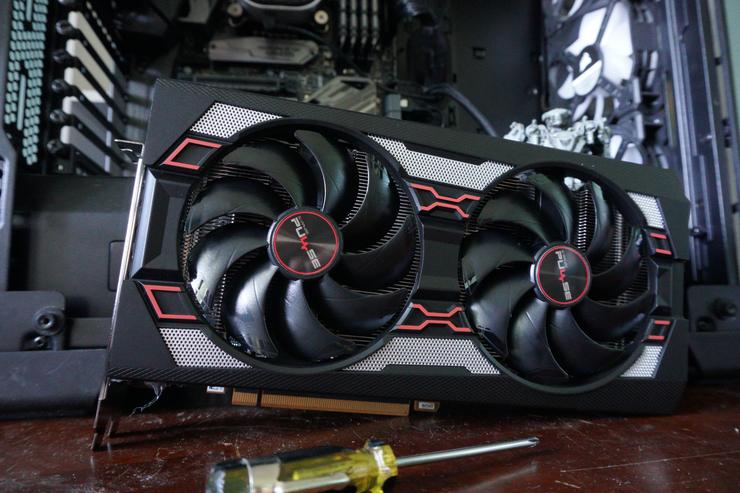 Credit: Brad Chacos/IDG
Credit: Brad Chacos/IDG
AMD promised that custom Radeon RX 5700 graphics cards would arrive in mid-August, and as of Monday, they’re here. The wait was worth it.
Sapphire’s kicking things off with its budget-friendly Pulse lineup. Like its predecessors, it offers some nice features and solid cooler designs at prices that won’t break the bank. But one of Sapphire’s most intriguing additions has nothing to do with hardware. We’re highly impressed by the new performance-enhancing, resolution-tweaking “Trixx Boost” feature in the company’s Trixx software suite, which leverages AMD’s Radeon Image Sharpening technology to great effect for everyday gamers.
Both the $359 Sapphire Pulse Radeon RX 5700 and $409 Sapphire Pulse RX 5700 XT go on sale today, with each commanding a mere nine dollar price premium over AMD’s Radeon RX 5700 series reference models. Now that’s some killer value. This is no paper launch either; Sapphire representatives told me that the cards will be “on shelf in good quantity” on August 12.
We received the more affordable Sapphire Pulse RX 5700 for testing, and to give away the ending, it delivers a whole lot of bang for your buck. This is a superb 1440p gaming option. Let’s take it for a whirl!
Sapphire Pulse RX 5700: Specs and features
The Pulse is powered by the same core GPU found in AMD’s reference models, Check out our original Radeon RX 5700 and 5700 XT review for a deep dive on its technical details, like ROP and transistor counts, and an overview of AMD’s new RDNA graphics architecture.
Here’s a more practical breakdown of the Sapphire Pulse RX 5700 and 5700 XT’s capabilities for gamers:
 Sapphire
SapphireThe card includes niceties new to the Radeon RX 5700 series, including 8GB of blazing-fast GDDR6 memory over a 356-bit bus, and cutting-edge PCIe 4.0 functionality if you’re running one of AMD’s excellent Ryzen 3000 processors in an X570 motherboard. PCIe 4.0 speeds are better suited to creative workloads, though.
For gamers, Sapphire bolstered the Pulse cards with mild overclocks. (The company’s no doubt saving beefier tunings for more capable Nitro-branded versions of the RX 5700 in the future.) The Pulse RX 5700 offers Base and Game Clock speeds of 1,540MHz and 1,700MHz, respectively, compared to the slower 1,465MHz and 1,625MHz reference speeds.
“Game clock” is new AMD terminology for the expected clock speeds you’ll see in gaming workloads, and equivalent to Nvidia’s Boost clock ratings. AMD’s Boost clock speeds are the maximum peak speed achievable in brief bursts, typically in non-gaming scenarios. We confirmed Sapphire’s card indeed hovered between 1,690MHz and 1,700MHz in gaming benchmarks.
 Sapphire
Sapphire
A blowout render of the Sapphire Pulse RX 5700 cooler.
The real value lays in the card design. While the first wave of Radeon RX 5700 offerings all stuck to the reference model’s ho-hum (but vastly improved) blower-style cooling, which uses a single fan to expel hot air out of the back of your system, the Sapphire Pulse RX 5700 deploys a more common dual-axial fan design. Dual-axial designs run cooler and quieter than blower-style options, but dump the hot air back into your system, relying on your case fans to circulate the heat out.
Sapphire equipped the Pulse Radeon RX 5700 with larger-than-usual 95mm fans atop a full-length heatsink. Larger fans can run quieter than standard-sized ones, but they push the width of the card about an inch past the norm. Be mindful of that if you’re hoping to cram the Pulse into a space-constrained mini-ITX case. It shouldn’t be an issue in typical tower cases.
 Brad Chacos/IDG
Brad Chacos/IDG
There's a cut-out in the backplate for the dual-BIOS switch.
The Sapphire Pulse makes much less noise than RX 5700 reference cards. You can reduce the volume even further, though, by activating the card’s secondary “Silent” profile via a physical dual-BIOS switch on the outer edge of the card. Doing so makes the card run much quieter but drops the GPU speeds to 1,465MHz Base / 1,625MHz Game clocks. The (very) slight drop in performance might be worth the acoustic improvement to your ears, though.
The focus on thermals continues under the hood. The Sapphire Pulse RX 5700 packs dedicated VRM and memory cooling to keep temperatures low, with a conductivity pad over the VRMs transferring heat to the graphics card’s full-length metal backplate—a nice extra to find on a card that costs just $9 more than reference designs. The 12-layer PCB includes 7+1+2 phase digital power and fuse protection against power surges, while the plastic shroud includes the Sapphire name in glowing red letters. A metal or firmer plastic shroud would be welcome, but again: Sapphire’s only charging $9 more for all these extras, and the card looks just fine in your case.
 Brad Chacos/IDG
Brad Chacos/IDGConnection-wise, the Sapphire Pulse RX 5700 packs a single HDMI port and a trio of DisplayPorts.
Soon, Sapphire will release an updated version of its Trixx overclocking and monitoring software that includes a new feature dubbed Trixx Boost. Boost creates custom display resolutions slightly under the standard monitor resolution for a noticeable performance boost, then uses AMD’s new Radeon Image Sharpening to minimize the visual impact. It’s great—but we’ll dive into that in a separate section after the standard performance benchmarks.
Next page: Our testing setup, gaming benchmarks begin

















